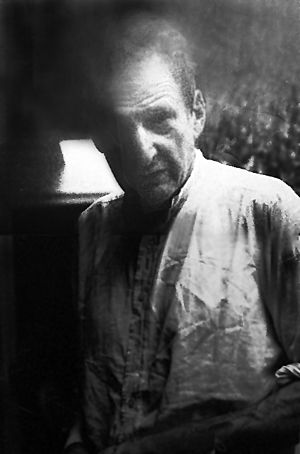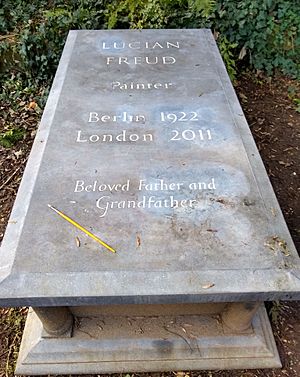Lucian Freud facts for kids
Quick facts for kids
Lucian Freud
|
|
|---|---|

Lucian Freud
|
|
| Born |
Lucian Michael Freud
8 December 1922 Berlin, Germany
|
| Died | 20 July 2011 (aged 88) London, England
|
| Education | Dartington Hall School Bryanston School Central School of Art |
| Alma mater | East Anglian School of Painting and Drawing Goldsmiths' College |
|
Notable work
|
|
| Spouse(s) |
Kathleen Epstein
(m. 1948; div. 1952)Lady Caroline Blackwood
(m. 1952; div. 1959) |
Lucian Michael Freud (born December 8, 1922 – died July 20, 2011) was a famous British painter. He was known for his realistic portraits of people. Many consider him one of the best portrait artists of the 20th century in England. He was born in Berlin, Germany. His father, Ernst L. Freud, was an architect. His grandfather was the famous Sigmund Freud. Lucian's family moved to England in 1933. This was to escape the rise of Nazism in Germany. He became a British citizen in 1939.
Freud's early paintings were influenced by surrealism. This art style often shows dream-like or strange images. But by the 1950s, his art became more realistic. His paintings often show friends and family. They are usually serious and use thick paint, called impasto. His art is known for showing deep feelings. He often explored the connection between the artist and the person he was painting. Freud was known for asking his models to pose for a very long time.
Contents
Who Was Lucian Freud?
Lucian Freud was born in Berlin, Germany. His mother was Lucie Brasch. His father was Ernst L. Freud, an architect. Ernst was the son of the famous psychoanalyst Sigmund Freud. Lucian was the second of three boys in his family. His younger brother was Clement Freud, a well-known broadcaster.
In 1933, his family moved to St John's Wood, London. They wanted to escape the growing power of Nazism. Lucian became a British citizen in 1939. He went to Dartington Hall School in Devon. Later, he attended Bryanston School for a year. He was asked to leave Bryanston due to his behavior.
Starting His Art Career
Freud studied art briefly at the Central School of Art in London. From 1939 to 1942, he studied at the East Anglian School of Painting and Drawing. This school was run by Cedric Morris. He also attended Goldsmiths' College in London. In 1941, he served as a merchant seaman. This meant he worked on ships during Second World War. He left the service in 1942 due to illness.
In 1943, a poet named Meary James Thurairajah Tambimuttu asked Freud to draw pictures for a book of poems. The book was called The Glass Tower. It was published in 1944. Freud had his first art show in 1944 at the Lefevre Gallery. In 1946, he traveled to Paris and then to Greece. He lived in London for the rest of his life.
The "School of London"
Lucian Freud was part of a group of artists. This group was later called the "School of London." These artists knew each other. They worked in London at the same time. They painted in a realistic style. This was different from the popular abstract expressionism art style of the time. Important artists in this group included Freud, Francis Bacon, and Frank Auerbach. Freud also taught art at the Slade School of Fine Art from 1949 to 1954.
Developing His Unique Style
Freud's early paintings were often small. They sometimes showed people, plants, and animals in unusual ways. Some of his very first works showed different skin tones. An example is Cedric Morris (1940). After the war, he started painting with thin layers of paint. He used soft colors. His self-portrait Man with a Thistle (1946) is an example. He also painted many portraits of his first wife, Kitty Garman. These included Girl with a Kitten (1947). He used tiny brushes for these works.
From the 1950s, he focused more on portraits. Girl with a White Dog (1951–1952) shows his changing style. He often cleaned his brush after each stroke. This made the colors in the skin look very varied. He also started painting while standing up. He continued this until he was very old. The colors in his later paintings became much brighter. By 1960, Freud had found his unique style. He used this style for the rest of his career. His later portraits were often very large.
Freud often included animals in his paintings. He would paint pets with their owners. Examples include Guy and Speck (1980–81). He loved horses and painted them often. He also included wilting houseplants in some portraits. In later works, he often painted piles of rags. These were the rags he used to clean his brushes. Some paintings from the 1980s show detailed views of London rooftops.
How He Painted
Freud's subjects were often people he knew well. These included friends, family, and other artists. He said his art was about his own life. It was about "hope and memory and sensuality." But he often gave his paintings simple titles. He did not always say who the person in the painting was. For example, the Duke and Duchess of Devonshire owned a painting of one of Freud's daughters. They did not know who the model was for several years. In the 1970s, Freud spent 4,000 hours painting his mother.
Freud started a painting by drawing on the canvas with charcoal. Then he would paint a small area. He slowly worked outwards from that spot. For a new person, he often started with the head. This helped him "get to know" the person. Then he painted the rest of the body. He would return to the head later. A part of the canvas was always left empty until the painting was finished. His finished paintings had many layers of paint. They showed months of careful looking.
Famous Works and Later Years
Freud painted other artists, like Frank Auerbach and Francis Bacon. He also painted the performance artist Leigh Bowery many times. He painted Henrietta Moraes, who was a muse for many artists. In the mid-1990s, he painted large portraits of Sue Tilley. She was known as "Big Sue." One of these, Benefits Supervisor Sleeping (1995), became very famous.
Freud's last painting was unfinished. It was a portrait of his studio assistant and friend, David Dawson. He also painted a portrait of the model Kate Moss. Freud was one of the most famous British artists who painted in a realistic style. He was nominated for the Turner Prize in 1989.
His painting After Cézanne was bought by the National Gallery of Australia. It is unusual because of its shape. Part of the painting was added to the main section. You can see a line where they were joined.
Many exhibitions of Freud's work were held. In 1996, the Abbot Hall Art Gallery showed 27 of his paintings. In 1997, the Scottish National Gallery of Modern Art showed his early works. From 2000 to 2001, the Museum für Moderne Kunst in Frankfurt showed 50 of his works. A big show was held at London's Hayward Gallery in 1988. The BBC made a TV show about it. In 2002, a large show was held at Tate Britain. In 2001, Freud painted a portrait of Queen Elizabeth II. Some people in the British media did not like this painting.
Lucian Freud passed away in London on July 20, 2011. He is buried in Highgate Cemetery.
His Paintings Are Worth a Lot!
In 2008, his painting Benefits Supervisor Sleeping (1995) sold for $33.6 million. This was the highest price ever paid for a work by a living artist at that time. In 2015, another painting, Benefits Supervisor Resting, sold for $56.2 million.
In 2011, his 1952 painting Boy's Head sold for almost $5 million. This small portrait was of his neighbor, Charlie Lumley. In 2015, Freud's 2004 painting The Brigadier sold for almost $35 million. This was a portrait of Andrew Parker Bowles in his army uniform.
His Family Life
Lucian Freud married Kitty Garman in 1948. They had two daughters, Annabel Freud and the poet Annie Freud. Their marriage ended in 1952. In 1953, Freud married Lady Caroline Blackwood. They divorced in 1959.
Lucian Freud had many children. Fourteen of his children have been identified. Two were from his first marriage. The writer Esther Freud and fashion designer Bella Freud are his daughters.
Where His Art Was Shown
- 1994: Metropolitan Museum of Art, New York
- 2000: Museum für Moderne Kunst, Frankfurt
- 2003: Museum of Contemporary Art, Los Angeles
- 2004: Scottish National Gallery, Edinburgh
- 2005: Museo Correr, Venice
- 2006: Acquavella Galleries, New York
- 2007: Irish Museum of Modern Art, Dublin
- 2008: Museum of Modern Art, New York
- 2008: Gemeentemuseum Den Haag, The Hague
- 2010: Centre Georges Pompidou, Paris
- 2012: National Portrait Gallery, London
- 2012: The Modern, Fort Worth
- 2013: Kunsthistorisches Museum, Wien
- 2016–2021: Irish Museum of Modern Art, Dublin
- 2019: Royal Academy of Arts
- 2022: National Gallery, London
See also
 In Spanish: Lucian Freud para niños
In Spanish: Lucian Freud para niños


